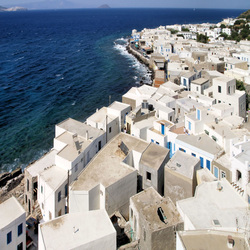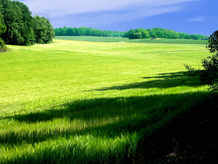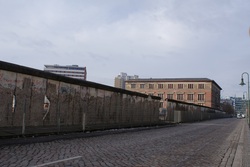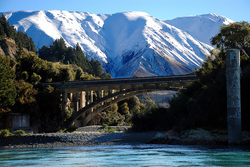The Teacher of the World...

Greece
"Europe has been a great teacher of the world. Almost every vital political principle active in the world today had its origin in Europe or its offspring, European North America...[T]he same is true of the arts. Even though other parts of the world have produced rich folk arts, the culture of the West has become dominant."
George F. Hepner and Jesse O. McKee, eds.,
World Regional Geography: A Global Approach
(Eagan, Minn.:West Publishing Co., 1992), p.144.
George F. Hepner and Jesse O. McKee, eds.,
World Regional Geography: A Global Approach
(Eagan, Minn.:West Publishing Co., 1992), p.144.
About Europe!
As of January 2007, there is a total of 37 countries that make up Europe.
May of 2004, ten new countries joined the European Union (EU), and as of January 2007, two more joined.
Ten of the twelve countries In Europe were formerly communist nations.
Europe is divided into 4 sub-regions:
May of 2004, ten new countries joined the European Union (EU), and as of January 2007, two more joined.
Ten of the twelve countries In Europe were formerly communist nations.
Europe is divided into 4 sub-regions:
- North Europe: which contains Scandinavia, Iceland, Denmark (including Greenland and Faroe Islands), Sweden, Norway, and Finland- as well as Estonia, Latvia, and Lithuania.
- West Europe: contains United Kingdom, the Republic of Ireland, France, Belgium, Luxembourg, the Netherlands, Germany, Switzerland, and Austria.
- South Europe: comprises Portugal, Spain, Italy, Greece, Malta, and Cyprus
- Central Europe: the largest sub-region has Poland, the Czech Republic, Slovakia, Hungary, Albania, Romania, and Bulgaria: and the two countries once known as Yugoslavia, Slovenia, Croatia, Bosnia and Herzegovina, Serbia (including Kosovo), Montenegro, and Macedonia.
Climate(s) in Europe!

Where you are in Europe greatly depends on the type of weather you will experience...
Depending on the Jet Stream, the Gulf Stream, and landscapes. Just as well as the vast amount of land that is covered. It ranges from cold and extreme changes in the North to nicer, less drastic weather patterns more towards the Southern region of Europe, and nice weather by the beach of the Mediterranean!
Depending on the Jet Stream, the Gulf Stream, and landscapes. Just as well as the vast amount of land that is covered. It ranges from cold and extreme changes in the North to nicer, less drastic weather patterns more towards the Southern region of Europe, and nice weather by the beach of the Mediterranean!
CLIMATE:
Temperate Midlatitude climate: Dominates most of North Western Europe. The climate is still fairly cool, although it is much warmer than any other climate at the same latitude.
Moderate Temperatures, and quite a bit of rainfall.
Mediterranean Climate: Warm dry summers, and mild rainy winters. In the summer, warm, dry air. In the fall the warm dry air shifts being replaced by cooler temperatures and thunderstorms sweeping in off the Atlantic Ocean. Climate is overall mild.
Humid Continental Climate: Summers are fairly hot, and winters are longer and colder, the deeper you go into in continent.
Moderate Temperatures, and quite a bit of rainfall.
Mediterranean Climate: Warm dry summers, and mild rainy winters. In the summer, warm, dry air. In the fall the warm dry air shifts being replaced by cooler temperatures and thunderstorms sweeping in off the Atlantic Ocean. Climate is overall mild.
Humid Continental Climate: Summers are fairly hot, and winters are longer and colder, the deeper you go into in continent.
DESCRIPTION:
Influences mainly by the Atlantic ocean this climate gets it weather from a broad warm-water current called the North Atlantic Drift which is the easternmost edge of the Gulf Stream. This brings large amounts of warm water that travels from Mexico, the air about the North Atlantic is warm and wet, and the eastward blowing winds push the warm wet air over northeastern Europe. People in the area have developed elaborate drainage systems, and they grow crops here such as: potatoes, beets, turnips, and cabbages.(that thrive in the cool wet conditions)
Warm dry air from North Africa shifts over the Mediterranean Sea that goes as far as the Alp Mountains. Which enables high temperatures clear skies and dry periods.
Crops that can be found in this climate consist of: olives, citrus fruit, and wheat. Must be drought-resistant and well irrigated.
Houses tend to be well insulated and with smaller windows that usual to hold in the heat in the cold winters. Crops have to be adapted to a shorter growing season because of the shorter summer. Snow and rainfall occur here.
Warm dry air from North Africa shifts over the Mediterranean Sea that goes as far as the Alp Mountains. Which enables high temperatures clear skies and dry periods.
Crops that can be found in this climate consist of: olives, citrus fruit, and wheat. Must be drought-resistant and well irrigated.
Houses tend to be well insulated and with smaller windows that usual to hold in the heat in the cold winters. Crops have to be adapted to a shorter growing season because of the shorter summer. Snow and rainfall occur here.
Population Patterns and Culture:

10,000 years ago was the started the practice of agriculture and animal husbandry. This came into Europe from the Tigris and Euphrates river valleys in Southwest Asia, known as Mesopotamia, and farther east and central Asia.
The first civilizations were ancient Greece (800-86 B.C.E.) and Rome (100 B.C.E.-450 C.E.)
These formed some of the most important cultural legacies of Europe.
Greek Philosophers: Herodotus, Socrates, Aristotle. Mathematicians: Pythagoras, Plato, Euclid.
These were some of the main people that were fascinated with the workings of both the natural world human societies. Literature, science, and arts, were heavily based upon Greek ideas. Romans based a great deal of their culture off of Greek ideas. Many Europeans speak Romance languages, Spanish, Portuguese, Italian, French, which were derived from Latin; the main language of the Roman Empire. The influence, although of Islamic civilization is normally over looked in Europe. North African Muslims (Moors) had a major influence on the language, music, food, and architecture. Also played a huge role in the belief systems in Spain which ruled form over 700 years. Muslims eventually brought Europe the Arabic numbering system as well as many advances in medicine, introduced algebra, and algorithms. Essential elements in modern engineering and architecture.
By the second century hundred of Roman towns were in Europe/ They were first noted in Egypt. Today there are about 525 million people in Europe, distributed unevenly.
The first civilizations were ancient Greece (800-86 B.C.E.) and Rome (100 B.C.E.-450 C.E.)
These formed some of the most important cultural legacies of Europe.
Greek Philosophers: Herodotus, Socrates, Aristotle. Mathematicians: Pythagoras, Plato, Euclid.
These were some of the main people that were fascinated with the workings of both the natural world human societies. Literature, science, and arts, were heavily based upon Greek ideas. Romans based a great deal of their culture off of Greek ideas. Many Europeans speak Romance languages, Spanish, Portuguese, Italian, French, which were derived from Latin; the main language of the Roman Empire. The influence, although of Islamic civilization is normally over looked in Europe. North African Muslims (Moors) had a major influence on the language, music, food, and architecture. Also played a huge role in the belief systems in Spain which ruled form over 700 years. Muslims eventually brought Europe the Arabic numbering system as well as many advances in medicine, introduced algebra, and algorithms. Essential elements in modern engineering and architecture.
By the second century hundred of Roman towns were in Europe/ They were first noted in Egypt. Today there are about 525 million people in Europe, distributed unevenly.
Twentieth Century....

"World Wars, Cold War, and Decolonization"
Between 1914 and 1945 two horribly destructive wars removed Europe from its position as the dominant region of the world. By the middle of the twentieth century Europe lay in ruins. Millions of people had a brutal death, caused by the Holocaust. "Ethnic Cleansing" from the Holocaust caused 6 million Jews, and millions of others like Roma, Slavs, the infirm and political dissidents, to be killed by the Nazi's. Post World War II in 1945, Germany was divided into two separate parts. Western Germany became an independent democracy allied with the rest of Europe, such as Britain, France, and also the United States. The line between West and East Germany became known as the Iron Curtain, which was a long fortified border zone. The Cold War was from 1945 to 1991, which is where the whole world became evolved, competing for dominance between the two superpowers: communism and freedom.
Between 1914 and 1945 two horribly destructive wars removed Europe from its position as the dominant region of the world. By the middle of the twentieth century Europe lay in ruins. Millions of people had a brutal death, caused by the Holocaust. "Ethnic Cleansing" from the Holocaust caused 6 million Jews, and millions of others like Roma, Slavs, the infirm and political dissidents, to be killed by the Nazi's. Post World War II in 1945, Germany was divided into two separate parts. Western Germany became an independent democracy allied with the rest of Europe, such as Britain, France, and also the United States. The line between West and East Germany became known as the Iron Curtain, which was a long fortified border zone. The Cold War was from 1945 to 1991, which is where the whole world became evolved, competing for dominance between the two superpowers: communism and freedom.
Gender Roles:
A large number of Europeans live in cities, marry later in life, and usually only have on average 1 child.
Women: Are found working outside the home as well as inside the home. Usually if a women works outside the home they are considered to have "double day" because when they arrive home the house and domestic duties they are expected to do as well. An increasing number of women are also working in factories, service workers, professionals, in the government and as elected officials.
Men: Have a greater social status in most places, hold more managerial positions, and have greater autonomy (freedom and movement) in life than women do.
Both men and women have a big part in determining the functions they should preform. Women are less able then men to preform the types of work that are typically done by men, as are men less skilled at the domestic duties that the women usually are expected to preform.
Even though the European Union is pushing more and more for gender equality, the political influences and economic well being is well behind men. Women make up less than one third of elected representatives, thus forcing women to have to rely on men to push for such legal measures as the right to work, equal job opportunities, and equal wages.
Women: Are found working outside the home as well as inside the home. Usually if a women works outside the home they are considered to have "double day" because when they arrive home the house and domestic duties they are expected to do as well. An increasing number of women are also working in factories, service workers, professionals, in the government and as elected officials.
Men: Have a greater social status in most places, hold more managerial positions, and have greater autonomy (freedom and movement) in life than women do.
Both men and women have a big part in determining the functions they should preform. Women are less able then men to preform the types of work that are typically done by men, as are men less skilled at the domestic duties that the women usually are expected to preform.
Even though the European Union is pushing more and more for gender equality, the political influences and economic well being is well behind men. Women make up less than one third of elected representatives, thus forcing women to have to rely on men to push for such legal measures as the right to work, equal job opportunities, and equal wages.
Social Welfare Systems in Europe
Social Democratic Welfare Systems:
are well developed in all Scandinavia, Sweden and Iceland.
Conservative Welfare Systems:
are found in the countries of West Europe except for the United Kingdom and Ireland.
Modest Welfare Systems:
presently found only in the United Kingdom.
Rudimentary Welfare Systems:
are found primarily in South Europe- Portugal, Spain, Italy, Cyprus, Malta, and Greece- And in Ireland.
Definitions from: pages 215-216. Pulsipher, L.M, and Pulsipher, A. (2008) World Region Geography, Global Patterns, Local Lives. Fourth Edition.
are well developed in all Scandinavia, Sweden and Iceland.
Conservative Welfare Systems:
are found in the countries of West Europe except for the United Kingdom and Ireland.
Modest Welfare Systems:
presently found only in the United Kingdom.
Rudimentary Welfare Systems:
are found primarily in South Europe- Portugal, Spain, Italy, Cyprus, Malta, and Greece- And in Ireland.
Definitions from: pages 215-216. Pulsipher, L.M, and Pulsipher, A. (2008) World Region Geography, Global Patterns, Local Lives. Fourth Edition.
These systems attempt to achieve equality across gender and class lines by providing generous health care, education, housing, and child and elder care benefits to all citizens from cradle to grave.
Citizens pay high taxes to provide and environment, from prenatal care on, in which every person's physical and social potential is realized.
They seek to provide a minimum standard of living for all citizens. Hence the state assists those in need, but it does not see its mission as assisting upward mobility. State programs may make a college education accessible to the children of poor families, but strict entrance requirements in some disciplines can be hard for the poor to meet. On the other hand, many state-supported services, such as health care and pension plans, are available to all economic classes.
Designed to encourage individual responsibility and the work ethic. Welfare is thought to encourage dependency, and the ideal citizen is completely self-reliant. Welfare recipients are often stigmatized in jokes and conversation as being lazy and "one the dole." The state claims no direct interest in the quality of its citizens' daily lives; how people live is thought to be a matter of individual choice in a free market, except that basic health care is provided free to all residents.
These countries do not accept the idea that citizens have inherent rights to government-sponsored support. Local governments provide some services or income for those in need, but the availability of such services vary widely,even within a country. Although rates are now low in these countries, the traditional extended family and community are still common, and the state assumes that when people are in need, their relatives and friends will provide the needed support.
Citizens pay high taxes to provide and environment, from prenatal care on, in which every person's physical and social potential is realized.
They seek to provide a minimum standard of living for all citizens. Hence the state assists those in need, but it does not see its mission as assisting upward mobility. State programs may make a college education accessible to the children of poor families, but strict entrance requirements in some disciplines can be hard for the poor to meet. On the other hand, many state-supported services, such as health care and pension plans, are available to all economic classes.
Designed to encourage individual responsibility and the work ethic. Welfare is thought to encourage dependency, and the ideal citizen is completely self-reliant. Welfare recipients are often stigmatized in jokes and conversation as being lazy and "one the dole." The state claims no direct interest in the quality of its citizens' daily lives; how people live is thought to be a matter of individual choice in a free market, except that basic health care is provided free to all residents.
These countries do not accept the idea that citizens have inherent rights to government-sponsored support. Local governments provide some services or income for those in need, but the availability of such services vary widely,even within a country. Although rates are now low in these countries, the traditional extended family and community are still common, and the state assumes that when people are in need, their relatives and friends will provide the needed support.
Physical Features

Alps Mountains:
This is the biggest mountain chain in Europe. It extends from Southwest France through Switzerland, Austria, and Slovakia, and curves southeast into Romania; stretching from west to east.
African and Eurasian Plate:
These are the two main tectonic plates in Europe. They range all the way from Europe, Iberia, Italy, to Greece. The African Plate is moving northward, as the Eurasian Plate is moving southeast. The Alps mountain range is a result of these two plates pressure when they collided.
Uplands:
The Uplands consist of many low lying hills and plateau's. They ranges from Dijon, France, through Frankfurt, Germany, to Krakow, Poland. They run northward from the central mountain zone, and they play a big role in the area because they from a transition zone between high mountains and the low lands of the Northern European Plain.
North European Plain:
This is a big plain that extends from the Atlantic coast in western France and stretches in a wide band around the northern flask of the main European Peninsula. Reaching across the English Channel and the North Sea to take in southern England, southern Sweden, and most of Finland. The North European Plain plays a big part in Europe because it allows a lot of good farming land to support the agriculture in Europe.
Coastal Lowland Zones:
The Coastal Lowland Zones are found in the North European Plain. Many of the main rivers run through this area, and contains many mineral deposits,which is good to irrigate crops. It is also is a very densely populated area all the way through Poland. The coastal lowland is an area of large Industrial Cities and densely occupied rural areas. This area had been transformed from natural seaside marshes and vast river deltas into farmland, pastures, and urban areas.
This is the biggest mountain chain in Europe. It extends from Southwest France through Switzerland, Austria, and Slovakia, and curves southeast into Romania; stretching from west to east.
African and Eurasian Plate:
These are the two main tectonic plates in Europe. They range all the way from Europe, Iberia, Italy, to Greece. The African Plate is moving northward, as the Eurasian Plate is moving southeast. The Alps mountain range is a result of these two plates pressure when they collided.
Uplands:
The Uplands consist of many low lying hills and plateau's. They ranges from Dijon, France, through Frankfurt, Germany, to Krakow, Poland. They run northward from the central mountain zone, and they play a big role in the area because they from a transition zone between high mountains and the low lands of the Northern European Plain.
North European Plain:
This is a big plain that extends from the Atlantic coast in western France and stretches in a wide band around the northern flask of the main European Peninsula. Reaching across the English Channel and the North Sea to take in southern England, southern Sweden, and most of Finland. The North European Plain plays a big part in Europe because it allows a lot of good farming land to support the agriculture in Europe.
Coastal Lowland Zones:
The Coastal Lowland Zones are found in the North European Plain. Many of the main rivers run through this area, and contains many mineral deposits,which is good to irrigate crops. It is also is a very densely populated area all the way through Poland. The coastal lowland is an area of large Industrial Cities and densely occupied rural areas. This area had been transformed from natural seaside marshes and vast river deltas into farmland, pastures, and urban areas.
A touch on Agriculture in Europe.
About two percent of Europeans are currently involved in full time farming. Their average farms is only about 45 acres. Their crops usually consist of beets, potatoes, turnips, cabbage, olives, citrus fruits, and wheat. They also have cows, sheep, and goats that are raised in pastures.
Environmental Issues:

This picture is a result of Acid Rain.
- Air Pollution: All of Europe produces about one quarter of the worlds carbon dioxide emissions by burning fossil fuels. Heavy over the European Plain because of the big Industries, dense transport routes, and high population densities. Consequences of the pollution is acid rain, which is a threat over most of Europe.
- Sea Pollution: Baltic Sea, the North Sea, the Arctic Ocean, the Atlantic Ocean, the Mediterranean Sea, and the Black Sea, are all water sources that surround Europe. Any pollutants that get in the river systems here end up eventually getting in any of the given names of surrounding water above. Sewage, eroded sediments, agricultural chemicals, industrial wastes, nuclear contaminants, and oil spills are pouring into the water. Solid wastes float on the seas surfaces. Algal booms because of all these pollutants resulting in inhabitable water for natural fish and sea life, as well as making resorts along the sea lines unsafe for swimming.
References:
Pulsipher, L.M., and Pulsipher, A. (2008). World Regional Geography: Global Patterns, Local Lives (4th ed.) Pages 183-243. New York: W.H. Freeman and Company.
